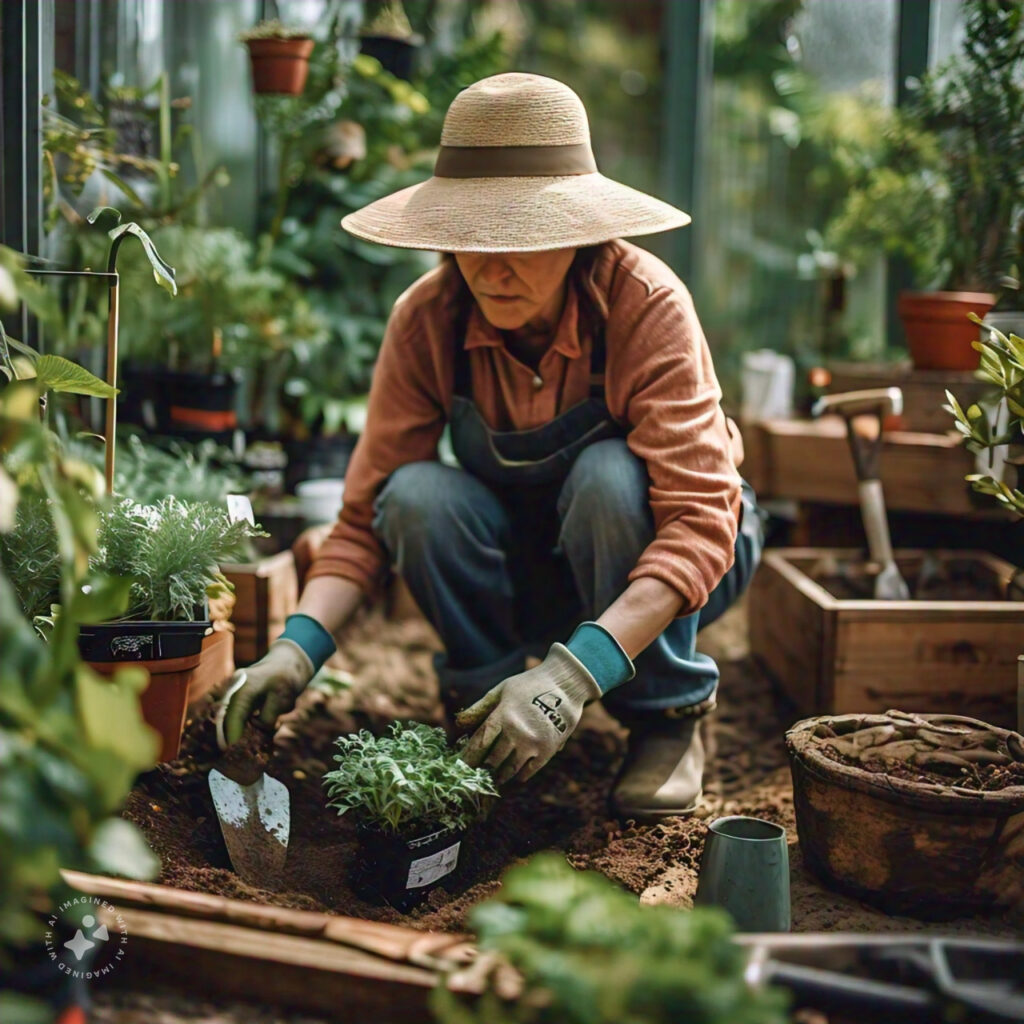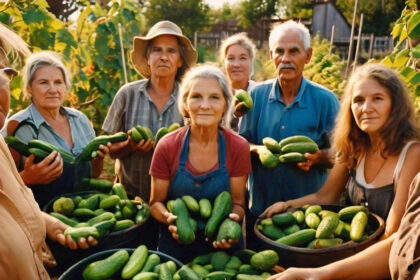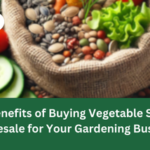Are you ready to turn your backyard into a lush, organic oasis? This will give you an organic garden planting guide that will help you create a thriving, eco-friendly garden. You’ll learn how to pick the best spot and manage pests naturally.

Start your journey to a sustainable, nutrient-rich future with us. This guide is perfect for both seasoned gardeners and beginners. It will give you the knowledge and tools to make your backyard a place of delicious, homegrown food. So, let’s get started and discover the secrets to a bountiful organic garden that will make your taste buds happy.
Laying the Groundwork: Choosing the Ideal Location
Choosing the right spot for your organic garden is key.
First, look at how much sun your site gets. Most plants need 6-8 hours of sunlight each day to grow well.
Also, think about how easy it is to get to your garden. Having it near your house makes caring for it simpler.
Sunlight and Accessibility Considerations
Some veggies like tomatoes and peppers love lots of sun. On the other hand, leafy greens like lettuce and kale can grow in the shade. Watch how the sun moves over time to pick the best spot.
Putting your garden close to your home makes it easy to take care of and enjoy your harvest.
Evaluating Site Conditions and Potential Obstacles
After picking a sunny spot, check for any problems like wildlife, poor soil, or slopes. Raised beds and containers help with bad soil. Adding organic matter and compost can also make the soil better.
Knowing your garden’s unique conditions and taking steps to overcome challenges will help your plants grow well. Adding windbreaks or row covers can protect your garden from harsh weather.
By thinking about your garden’s location and solving any problems, you’ll create a thriving organic garden. This garden will give you lots of fresh, healthy food and a sense of pride.
Building a Rich Foundation: Preparing the Soil
Healthy, nutrient-rich organic soil is key for a thriving garden. Start by adding lots of high-quality compost. Compost boosts the soil and helps the good microorganisms that plants need to grow.
Adding other organic stuff like leaves, straw, or aged manure also helps. These items make the soil better, hold more water, and give plants the nutrients they need.
The Importance of Nutrient-Dense Soil
Organic soil full of nutrients is vital for a healthy garden. Plants need different nutrients, so your soil should have them. A soil test shows what nutrients you need to add.
Soil pH should be between 6.0 and 7.0 for plants to grow well. You might need to adjust the pH with lime or sulfur based on your soil test.
Incorporating Organic Matter and Compost
- Adding compost makes the soil better at holding water and nutrients.
- Use other organic stuff like leaves, straw, or aged manure to make the soil even better.
- Compost gives plants the nutrients they need and adds good microorganisms.
- Putting in the effort to prepare the soil well leads to strong, healthy plants all season.
Creating a rich, nutrient-dense organic soil base sets you up for a great garden. Healthy soil is the secret to a successful garden.
Start Small, Start Right: Scaling Your Garden
Starting your organic garden small is a smart move. Don’t plant too many crops at once. Focus on a small area you can handle well. This way, you learn the basics of organic gardening without getting overwhelmed.
As you get more confident and skilled, you can grow your garden size. Start with an intensive planting area. Here, you arrange your crops carefully to use space well. This saves resources and keeps your garden healthy and productive.
If you have little outdoor space, container gardening is a great choice. Use pots, planters, and raised beds to create a garden in even the smallest spaces. This method lets you try out different plants and adjust easily to changes.
Starting small and building a strong foundation is key to a successful organic garden. With patience and hard work, your garden will grow and give you lots of fresh, tasty produce.
- Begin with a manageable garden size that you can easily maintain.
- Embrace intensive planting techniques to maximize your available space.
- Explore the benefits of container gardening for small-space gardeners.
- Gradually expand your garden as your skills and confidence grow.
Choosing Your Crops: Edible Delights for Every Palate
Start by picking the right vegetable varieties and heirloom seeds for your garden. Think about what you and your family love to eat. This way, you’ll get the most out of your garden and enjoy the process.
Focusing on Favorite Veggies and Herbs
First, list the veggies, herbs, and fruits you and your family love. Do you adore the taste of fresh tomatoes or the crunch of carrots? Maybe you’re a fan of herbs like basil or thyme. Adding these favorites to your garden plan makes for a rewarding harvest.
Selecting Suitable Varieties for Your Climate
After picking your top crops, find ones that fit your local climate. For instance, cool-weather crops like lettuce do well in spring and fall. Warm-season crops like peppers love the summer heat. Also, consider companion planting to keep pests away and help your plants grow better.
Customize your garden to your tastes and climate for a great harvest. Enjoy watching your favorite plants grow and taste the fresh, delicious results of your hard work.
For a successful organic garden, balance your food likes with your local climate. With some research and creativity, you can make a garden that delights your senses and feeds your body.
Nurturing Your Plants: Water and Pest Management
It’s key to keep your plants well-watered for their health and growth. Use a drip irrigation system to water them right at the roots. This cuts down on waste and helps roots grow deep and strong. Drip lines or soaker hoses work great for giving plants a steady water supply.
Keeping pests away is also vital for a healthy garden. Row covers are a top choice for organic pest control. These fabrics act as a barrier, keeping insects, birds, and small animals away from your crops. They also protect against frost, helping you grow plants longer and keep them safe from sudden weather changes.
Establishing an Efficient Irrigation System
Drip irrigation is perfect for organic gardens because it waters plants right at the roots. This cuts down on evaporation and makes sure plants get the moisture they need. Here are some tips for a good irrigation system:
- Put drip lines or soaker hoses near your plants’ roots.
- Adjust the water flow and schedule based on your plants’ needs and the soil and weather.
- Use a timer or controller to water plants at the same time every day.
- Check and fix any problems with your irrigation system often to keep it working well.
Utilizing Row Covers for Protection
Row covers are great for keeping pests out of your garden. They act as a barrier, stopping insects, birds, and small animals from getting to your plants. Here’s how to use them best:
- Pick row covers that let sunlight, air, and water through but keep pests out.
- Put the covers over your plants, making sure they fit well around the edges.
- Take off the covers sometimes to let pollinators in and to check on your plants.
- Use row covers with other pest control methods, like planting certain plants together, for better protection.
With a good drip irrigation system and row covers, your plants will get the right amount of water and protection. These steps will help you grow a big, chemical-free harvest.
organic garden planting guide: Embracing Organic Methods
Organic gardening is all about using eco-friendly methods that work with nature. Say no to synthetic chemicals and choose natural ways to fight pests and enrich soil. By following organic gardening, you can grow a healthy garden that feeds your family and protects the planet.
Water conservation is key in organic gardening. Using drip irrigation can cut water use by half. This helps save water and is good for the environment. Saving seeds has become more popular, showing a love for preserving old plant types and keeping nature diverse.
Most organic gardeners prefer natural fertilizers. They like compost tea, fish emulsion, and bone meal for their green benefits and effectiveness. The organic gardening market is growing by 7% each year, showing more people want to garden in a green way.
Starting an organic garden is easy. Add organic matter and compost to your soil for a healthy base. Use row covers and frost protection to keep pests and bad weather away from your plants.
- Organic seeds and seedlings offer many choices for your garden
- Use Bt, Neem oil, or insecticidal soap to fight pests safely
- Hand-pull weeds and welcome ladybugs, lacewings, and bees to keep pests away naturally
By choosing organic gardening, you help the planet and get a garden full of healthy food. It’s a win-win for you and the earth.
Conclusion: Reaping the Rewards of Your Organic Oasis
By following this guide, you’re on your way to a thriving, eco-friendly garden. You’ll enjoy homegrown produce full of nutrients. You’ll also feel the joy of sustainable gardening and the peace of your organic haven.
Your organic garden helps you and your family eat healthier. It also makes the environment better. You’ll see more beneficial insects and wildlife, and your garden will help the soil and support many plants.
Keep up with your organic garden and be proud of your role in a sustainable future. Enjoy your heirloom tomatoes, fresh herbs, and the beauty of your garden. Your hard work will show in every bite and moment in your organic garden.





